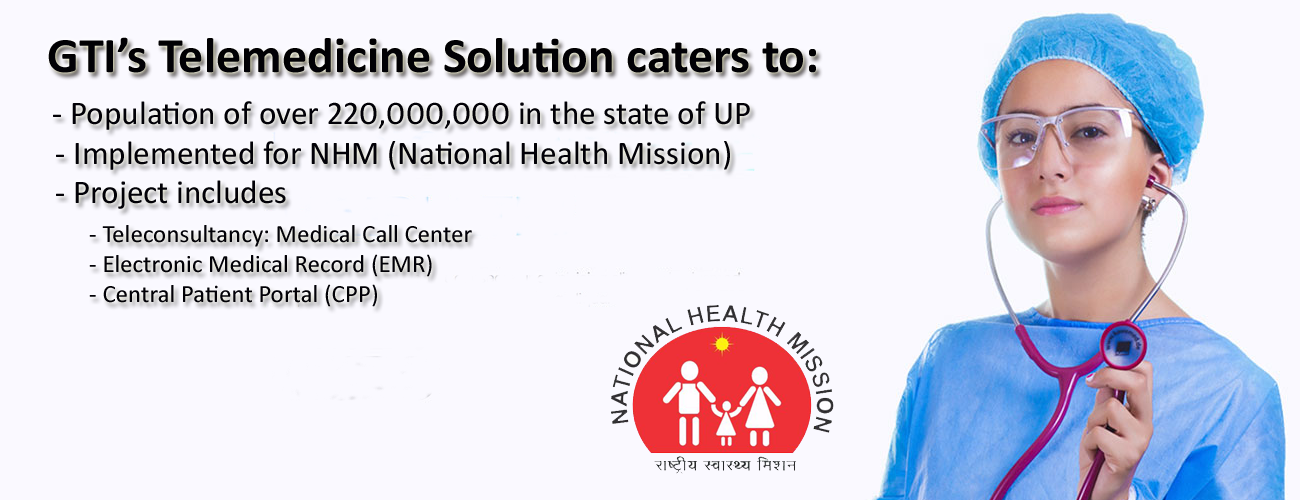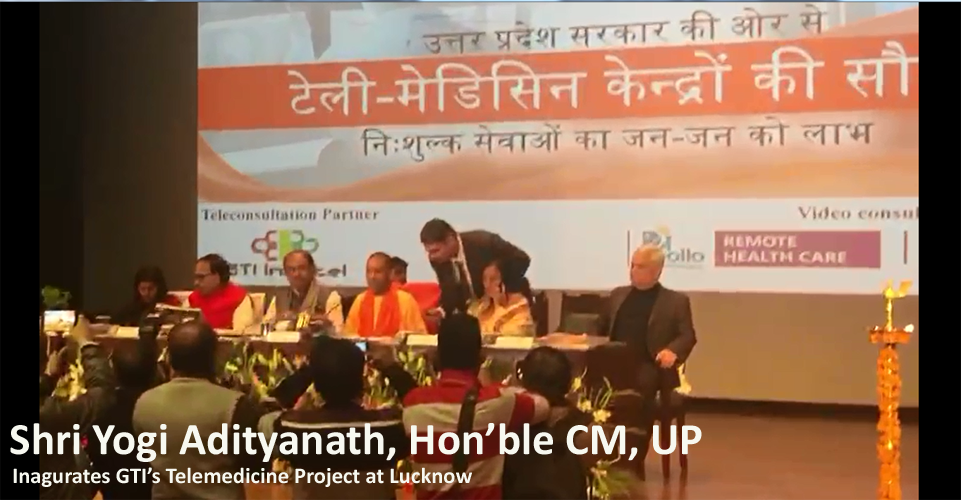TELEMEDICINE
Telemedicine is the distribution of health-related services and information via electronic information and telecommunication technologies. It allows long-distance patient and clinician contact, care, advice, reminders, education, intervention, monitoring, and remote admissions. Telemedicine is being used as remote clinical services, such as diagnosis and monitoring. GTI’s Telemedicine technologies hold tremendous potential as they help improve clinical management, reduce diagnostic differences and provide efficient treatment by increasing efficiency and access to healthcare services. The global telemedicine market size was US$ 34.28 billion in 2018 and is projected to reach US$ 186.66 billion by 2026, exhibiting a CAGR of 23.5% in the forecast period.
-
Global Telemedicine Outlook
The global market size of telemedicine in 2019 was estimated at USD 41.4 billion and is projected to see a CAGR of 15.1 per cent over the forecast period. Telemedicine technologies hold tremendous potential as they help improve clinical management, reduce diagnostic differences and provide efficient treatment by increasing efficiency and access to healthcare services. Sudden global corona virus epidemic is expected to improve telemedicine use as these tools help caregivers easily interact with their patients during the pandemic and offer better tools to their health issues. Digital care delivery is growing up as an efficient option for secure and better communication, thanks to social distancing introduced by different countries around the world. The WHO has listed telemedicine as one of the policy's critical resources for responding to the emergency COVID-19. Telemedicine minimizes appointment time and improve the quality of rural healthcare services, removing many infrastructural challenges. To overcome such challenges requires the adoption of technologies which bring together both people and facilitators. Telemedicine also finds its use in areas where large populations meet occasionally / periodically at a time when providing medical care becomes the hour's need.
-
Indian Telemedicine Outlook
The WHO suggests a doctor-population ratio of 1:1000 whereas the actual doctor- population ratio in India is only 0.62:1000. For a developing country like India, there are major gaps in the provision of healthcare. Though nearly 75 percent of Indians live in rural villages, over 75 percent of Indian doctors live in towns. Furthermore, poor Indian villagers spend most of their out-of-pocket health expenses on commuting to the town's specialty hospitals and living with their escorts in the town. Telemedicine can turn out to be the easiest way to bridge the rural – urban health gap, as well as the fastest. Taking into account India's tremendous advances in information and communication technology, telemedicine could help bring advanced healthcare to the country's remotest corners. Telehealth will also help healthcare systems, agencies, and providers increase access to rural healthcare and enhance the quality. Use of telehealth to provide and support healthcare services in remote areas may eliminate or mitigate barriers and pressures faced by patients, such as mobility difficulties related to traveling for specialty treatment. With the help tele medicine, patients do not have to visit the clinic, wait in long queues, crowd and be a threat in the spread of Hospital Acquired Infections.
-
Why Telemedicine in India now?
Given the doctor-population ratio in India, the best medical experts are not reached by many people living in smaller towns and rural communities in India. Moreover, hospitals and hospital facilities will be able to triage and track exponentially more patients with telehealth vs. an in-person visit of patients being treated at their own homes. By leveraging a large number of expert physicians in India to support a large number of the country's citizens, telemedicine bridges the current gaps in India that make physical distance a barrier to accessing quality medical care. Conversely, in the largest towns, there are still many Indians who do not have access to the most basic facilities of life. With the coronavirus becoming a pandemic in 2020, healthcare networks and telehealth providers see this as an opportunity to put related health to the forefront-and reshape the healthcare future. Tele health is the answer that India is looking for in the wake of this pandemic as it prevents emergency rooms to be overcrowded, prevents the interaction of patients and health care workers, and cut down the use of masks gowns and gloves. Earlier the guidelines from the Government of India was not conducive to provide Telemedicine services. However, in March 2020 the Government released new telemedicine guidelines clarifying regulations for the industry. Please refer https://www.mohfw. gov.in/pdf/Telemedicine.pdf.
Telemedicine Process by GTI
Theoretically speaking, 70 percent of healthcare issues can be handled by physicians residing in a remote place — connected by telemedicine. GTI Telemedicine platform brings patients, healthcare workers, care givers, pharmacist and labs together to provide the best in class healthcare services. The platform works across Mobile, Tablet and PC to provide patients (or their care giver) virtual appointments with the best physicians from all over India. The Patient can select a Physician close to home or
anywhere in the country, thus ensuring the best care possible.
The company has a tie-up with several hospitals, nursing homes, physicians, and specialists across the country. It has further tied up with Laboratories and Pharmacist across the nation for a at home service. GTI’s consultation software is powered by an Artificial Intelligence engine to support the Doctor giving the correct Clinical Decision Support System. Within this software, doctors have access to the unique assistive tool that lets them examine the symptoms and give their patients reliable
results.
The process to receive GTI Telemedicine services for the patient or their caregiver is very simple:
-
1. Call the GTI Medical Center:
The Patient simply calls the GTI Medical Call Center where an expert medical processional understands their requirements and immediately connects/schedules them to the relevant Specialist.
-
2. Connect over App/Website:
The patient also has the option to connect with the Physician by providing relevant information over the App. The App and the Web based software gives the power to connect right in the palm of their hands. -
3. ePrescription:
The Patient is provide with ePrescription over their mobile phone with all the details. They can always call up the call center with any queries that they may have.
-
4. Delivery of Medicine: Once the ePrescription is done, the patient can avail the service of door step delivery of medicines. GTI has tied up with various pharmacies to deliver medicines to the patient’s home. -
5. Laboratory Tests: In case the doctor recommends a Lab tests, the same can be arranged by GTI at the patient’s doorsteps. GTI has tied up with various laboratories nationwide to ensure the best services to the patient. -
6. Patient Medical Record:
Electronic Medical Record (EMR) is the key to patient safety. The system keeps the EMR of the patient that includes medication, test results, etc. This information helps both the patient and the Doctor.










